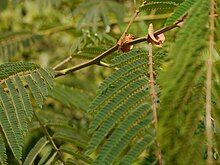| Albizia chinensis | |
|---|---|
 | |
| Bark of Albizia chinensis | |
| Scientific classification | |
| Kingdom: | Plantae |
| Clade: | Tracheophytes |
| Clade: | Angiosperms |
| Clade: | Eudicots |
| Clade: | Rosids |
| Order: | Fabales |
| Family: | Fabaceae |
| Subfamily: | Caesalpinioideae |
| Clade: | Mimosoid clade |
| Genus: | Albizia |
| Species: | A. chinensis |
| Binomial name | |
| Albizia chinensis | |
| Synonyms | |
List
| |
Albizia chinensis is a species of legume in the genus Albizia , native to south and Southeast asia, from India to China and Indonesia. [1]
Contents
The genus is named after the Italian nobleman Filippo degli Albizzi, belonging to the famous Florentine family Albizzi, who introduced it to Europe in the mid-18th century, and it is sometimes incorrectly spelled Albizzia.

